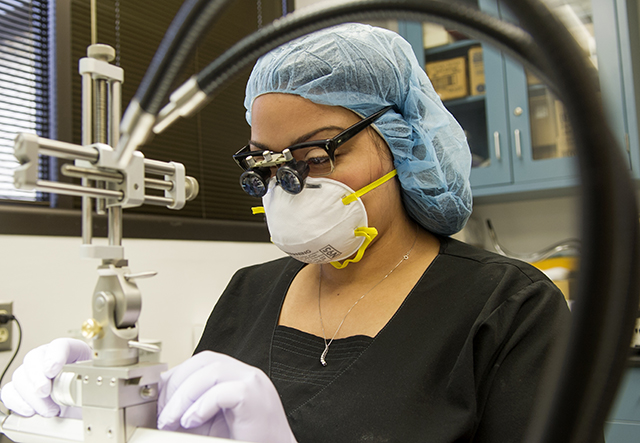Continued growth in store for dental scientist

As Dr. Crystal Stinson ’14 prepares her dissertation on the role of hormones with post-herpetic nerve pain, she’s transitioning into the next phase of her career at Texas A&M College of Dentistry with the Harold Amos Medical Faculty Development Program, a $420,000 postdoctoral research award. Stinson is just the sixth dentist to be given the award, created by the Robert Wood Johnson Foundation to increase the number of physicians, dentists and nurses from historically disadvantaged backgrounds committed to achieving senior rank within their academic institutions.
The award allows her to continue working in the lab of Dr. Phillip Kramer, professor in biomedical sciences, all the while delving deeper into her own research interests. She’ll teach and even have a designated private practice day. The ultimate goal: “I hope to eventually be in upper academia, with an associate deanship,” Stinson says. “Even if I’m not able to be at the bench all the time, hopefully I’ll always have some research. I will stay a pain researcher. I have a burden for it,” adds Stinson, who has dealt with orofacial pain from her own temporomandibular joint disorder.
“This is a great opportunity,” Stinson says of the program, which also gives participants access to mentor support, as deans and executive deans comprise the advisory committee. “All the candidates who complete the program are able to venture into tenure track positions,” Stinson continues.
“That’s the goal of the foundation, to increase the number of minorities in positions where we have the opportunity to mentor others, because what they are seeing in trends is that if it’s not a historically minority university, these types of institutions have very little representation as far as mentors and teachers for their minority students. Some psychological research has shown that when you are a minority, and you identify with someone who has achieved what you are trying to achieve, it helps.”
Redirected focus
When Stinson embarked upon her doctorate in biomedical sciences just after finishing her dental degree, her focus was trained on estrogen and TMJ pain. Then things changed.
A resurgence in the incidence of shingles — caused by varicella zoster, the same virus as chicken pox, and producing a telltale blistering rash — prompted the shift. Once resolved, shingles can result in post-herpetic neuralgia, a severe, debilitating pain that lingers for months to years after the rash has cleared. What’s worse: This specific type of pain is not responsive to traditional anti-inflammatories or opioids.
“Because of that burden of the disease and the issues associated with it, the research changed direction,” says Stinson, who for the last two years has assisted Kramer in developing an animal model that presents orofacial symptoms associated with shingles.
“There is no other model that has been able to do that,” Stinson says. “It mirrors what happens in the human disease process really closely. It’s a good way to study treatment modalities and different drugs.” Sex differences, mainly estrogen in females, are also scrutinized.